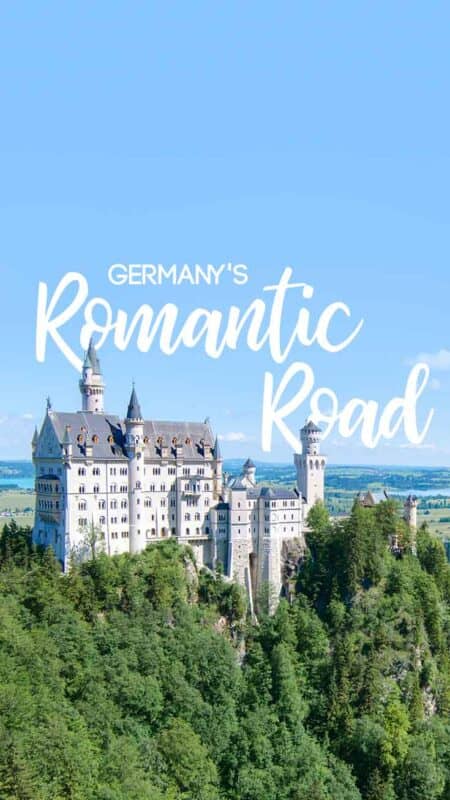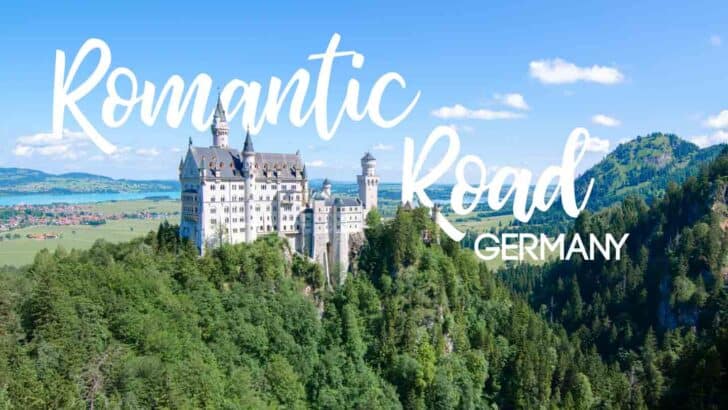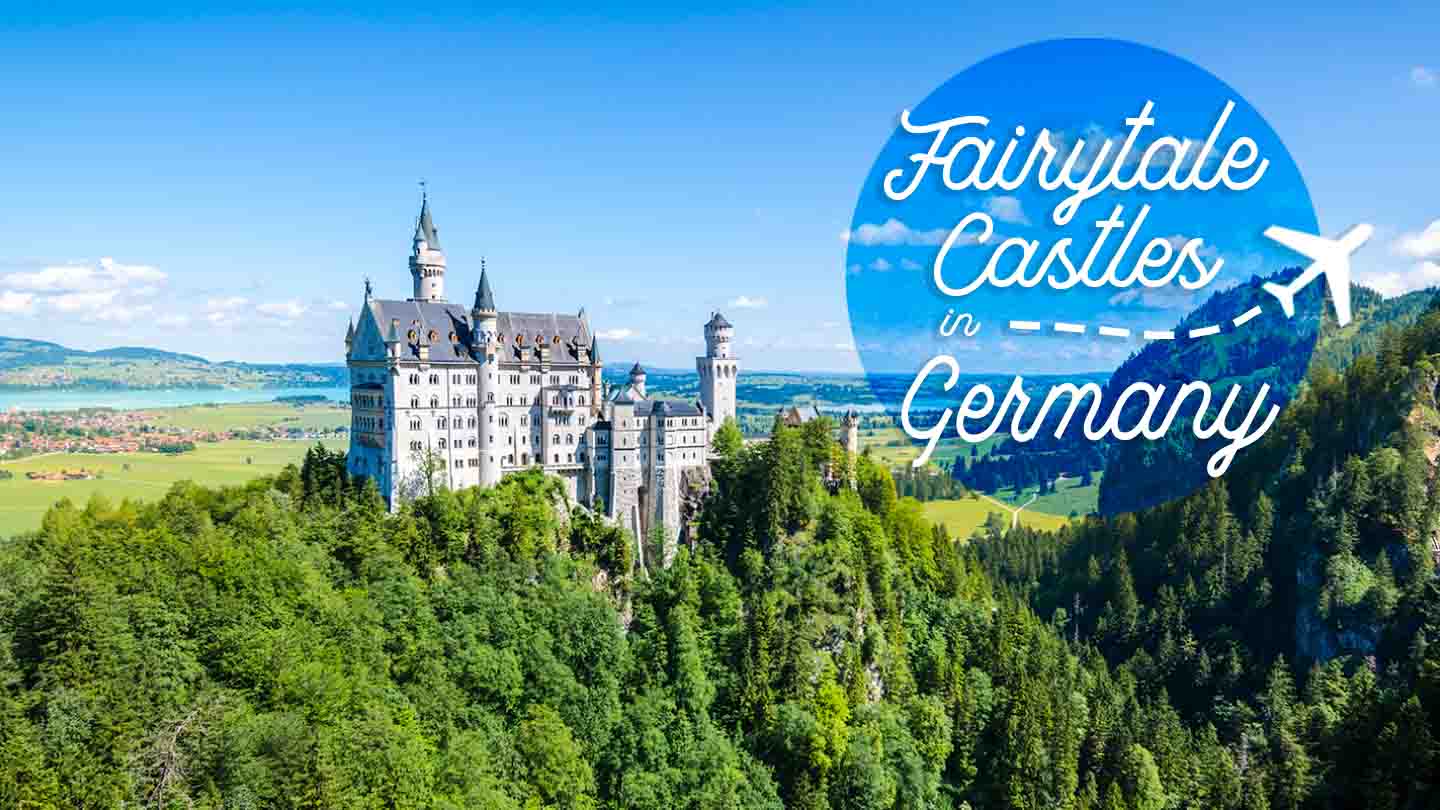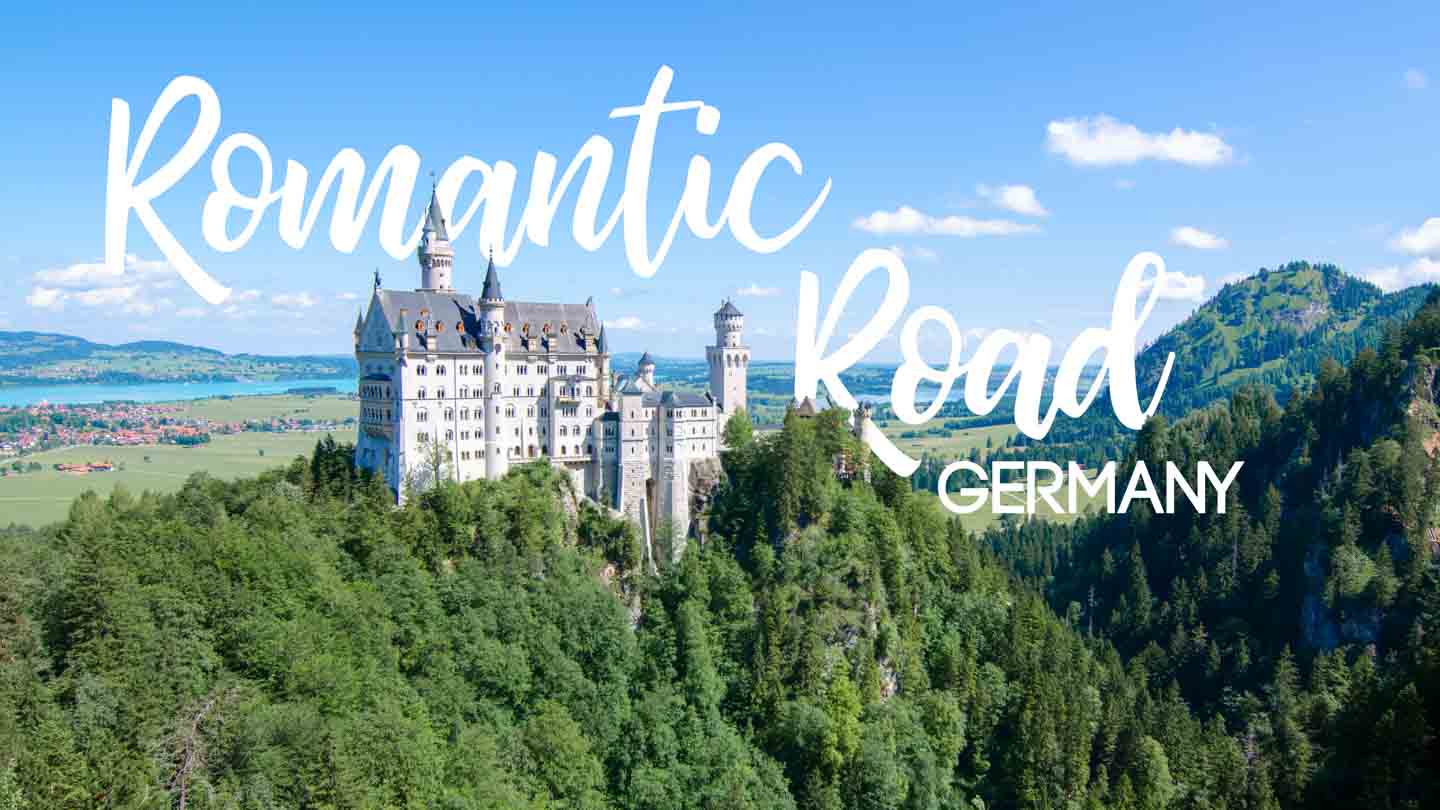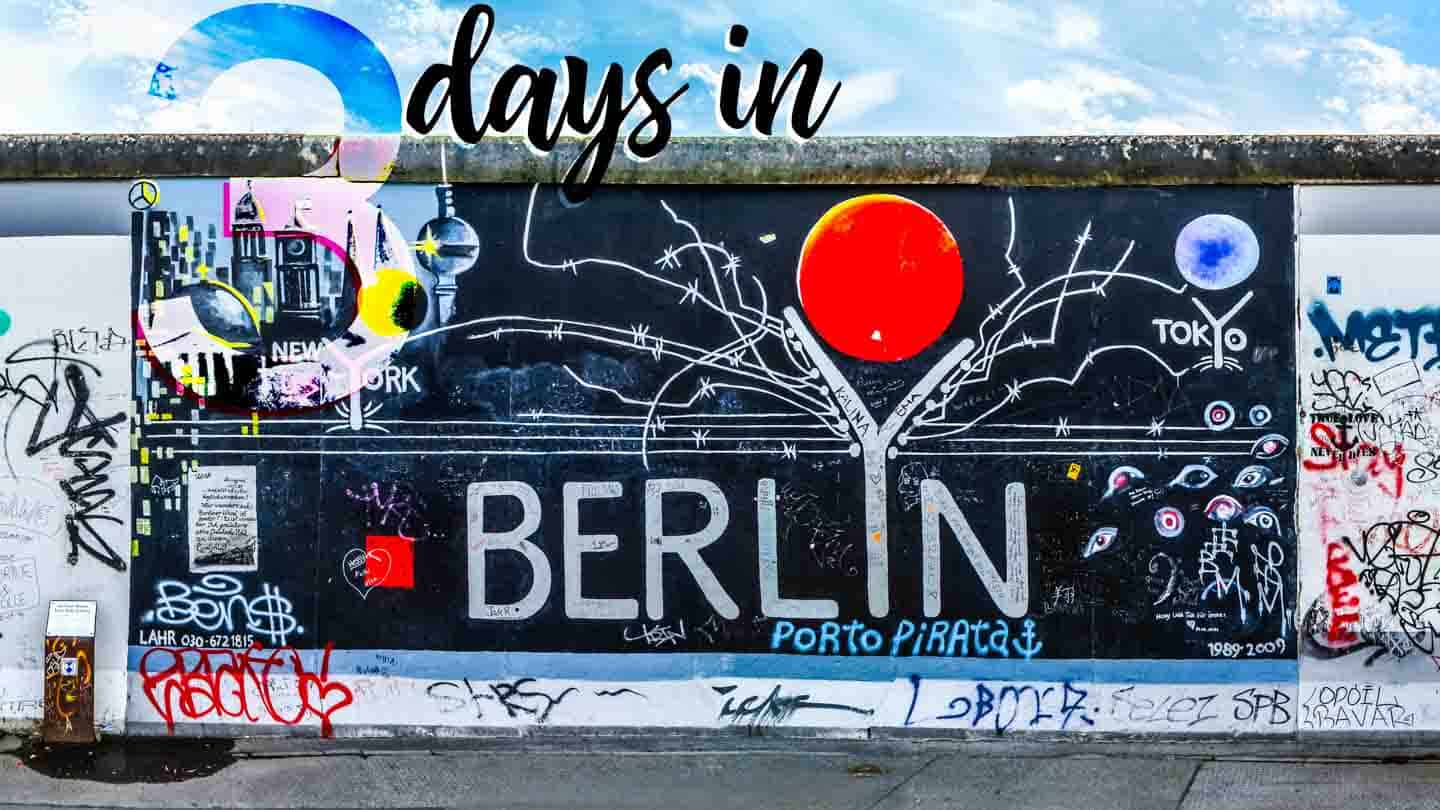Germany’s Romantic Road takes you on a historical path through Southern Germany. The Romantic Road, or Romantische Straße as the Germans call it, is a journey from Wurzburg to Füssen. Wherever you wish to begin is up to you, but most start at Wurzburg because of its central location.
We wanted to create this guide to the Romantic Road in Germany because we couldn’t find a useful guide with itineraries, maps, and pictures all in one place, or at least that would translate well into English.
So, after driving this route in its entirety twice, we decided to make our complete guide to Germany’s Romantic Road to help travelers make the most of their time in Bavaria.
Regardless of where you start, the Romantic Road is a great way to take in the scenic beauty Germany has to offer and visit some fairytale castles in Germany. Bring your lederhosen (very optional, more of an expression than a suggestion) because there are plenty of stops to experience the local Bavarian culture.
Here, we’ll try to fill you in on some of the best stops and things not to miss during your Romantic Road trip.
Jump to Information on:
- Romantic Road Itineraries
- Romantic Road Tours
- Best stops Along the Romantic Road
- Romantic Road Tips & FAQ
Cheapest Rental Car in Germany
If you plan on driving the Romantic Road, you’ll need to book a rental car. We have personally rented cars in Germany on four different trips and can’t imagine not renting a car in Germany.
Driving in Germany is relatively easy. The roads are well-marked, and the drivers are courteous. We always rent on Discovercars.com. They always seem to have the lowest prices and free cancelations.
Make sure to prepay your rental car. That way, you guarantee your vehicle and price. Click here to check rates. We rented a Volkswagon station (often listed as an Estate car) for one week, and it was under $200.
Romantic Road Itineraries
Germany’s famous Romantic Road is 400km long, and the time you need to explore it depends on how many stops you want to make. For the average tourist, we suggest a 3-day itinerary for the Romantic Road.
However, if you are a history buff or can’t pass up a beautiful little German town – then you could easily spend a week or more exploring churches, small towns, and of course, a few beer gardens. We have mapped out the 3 or 4 most popular itineraries to tackle the Romantic Road.
There are tons of castle hotels and traditional German homes you can rent on Vrbo. On our last trip to Germany, we did a Germany road trip and drove the entire Romantic Road and only stayed in Vrbo, like this German castle Vrbo and this German Castle Vrbo.
*When looking for the best price and biggest selection of hotels, check prices on Booking.com. We’ve found they are the best option and have a great cancelation policy.*
Romantic Road Day Trip From Munich
A very popular place to explore the Romantic Road from is Munchin. While you won’t get to see the entire road on just a day trip, you can catch a few of the highlights in only one day from Munich. The best approach is to make a loop, either starting south to Neuschwanstein Castle and then heading north. Choosing a few villages to see toward Augsburg before heading back to Munich.
Munich -> Füssen/Neuschwanstein Castle -> Schongau -> Landsberg -> Augsburg -> Munich
Romantic Road Day Trip From Frankfurt or Nuremberg
The cities of Frankfurt and Nuremberg are closer to the northern section of the Romantic Road. Which makes it easy to see many of the beautiful old walled towns in just one day.
The best approach is to create a loop starting in either the north or the south. Ending in the south will let you spend your time in the most impressive cities, but will be a long drive at the end of the day back to the city you are staying in.
Frankfurt or Nuremberg -> Wurzburg -> Rothenburg -> Dinkelsbühl -> Nördlingen (if time) -> Return
2-Day Romantic Road Itinerary
If you have just one night to spend along the Romantic Road, we suggest spending it in one of two places, either in Rothenburg or in Füssen. These towns hold some of the top sights along this route.
Füssen has two amazing castles as well as beautiful mountains and a lively tourist center. While Rothenburg is one of the best-kept Midivil cities left in Germany, it simply oozes old-world charm.
With two days, it’s best to break the trip up between north and south. Spend one day exposing the north and the second in the south. However, with this much time, most of your days will be full with the highlights and fewer with minor stops.
One day: Wurzburg -> Rothenburg ODT -> Dinkelsbühl -> Harburg -> Füssen (Spend the Night)
Second Day: Füssen -> Schongau -> Augsburg -> Nördlingen
3-Day Romantic Road itinerary
A three-day trip down the Romantic Road is just enough time to catch the highlights of the route. If you have any more time in your schedule, it’s a good idea to add another day or two. Aside from the major attractions, many fascinating stops will have you pulling over for pictures and exploring little charming Bavarian villages. (Routes can be reversed to fit your trip)
Day 1 Wurzburg to Rothenburg odT
Start your day at the Wurzburg Residence to see the stunning palace and extensive gardens. Make your way out of Wurzburg and down the Romantic Road heading south.
Wurzburg -> Bad Mergentheim -> Rothenburg odT (Spend the night)
Day 2 Rothenburg odT to Füssen
Sunset is one of the best times to visit Neuschwanstein Castle anyway, so spend the afternoon inside the castles and head to one of the many great viewpoints for sunset, like Mary’s Bridge.
An overnight in Füssen is also helpful because it will give you two chances to catch a beautiful day to see the famous castles.
Rothenburg ODT ->Dinkelsbühl -> Nördlingen -> Harburg -> Füssen (Spend the Night)
Day 3 Füssen to your next German destination
Spend your morning exploring Neuschwanstein Castle and Hohenschwangau Castle if you didn’t make it here the day before. Once you’ve taken all of your pictures, if you are heading back toward the north, take time to make stops along the villages you might have missed on the way down to Füssen.
Other Stops worth seeing: Augsburg, Schongau, Schwangau
Romantic Road Germany Tours
If all of this planning sounds too stressful, there are a handful of companies that take all the work off of your plate that offers a full-service tour for you to explore the Romantic Road.
While self-driving the Romantic Road is relatively easy and straightforward, many people would rather not be behind the wheel on the Autobahn. If that’s you, a Romantic Road tour might be for you.
Recommended Romantic Road Tours
The Romantic Road Bus
Another good option to see Germany’s Romantic Road if you don’t want to drive the route is by coach buses that drive the route daily. You can buy a bus ticket in a single direction (north or south) in a semi-hop on hop-off fashion.
You can arrange this on the ground in Germany, but during the summer and peak seasons, it’s best to arrange it in advance. Email [email protected] for details or call +49(0)69 719126-141/261 (Mon-Fri, 9-18 hrs).
Romantic Road by Train
The Romantic Road Railway connects three beautiful towns along the Romantic Road and can be a fun way to explore this historic route.
You can take the train between the cities of Nördlingen -> Dinkelsbühl -> Feuchtwangen.
The Best Stops on the Romantic Road in Germany
While each of the stops is closely connected by proximity and in history, there isn’t just one single path on this journey. Some visitors to the Romantic Road have more time than others.
For that reason, we want to show you all of the options and give our recommendations on which places you could spend your time and places that absolutely can not be missed. At the bottom of each of the cities along the Romantic Road, we have listed whether you should stay the night or just visit during the day or as part of a tour.
If you are tight on time, we have listed each city by how important a stop it is. A few stops are listed as “Optional” for cities that are beautiful in their own right but could be missed in favor of more impressive sites. A few cities along the route we have listed as “Should See” and as the name suggests should be part of a quality Romantic Road tour, but you could be forgiven if you pass them up for our final category. Lastly, cities listed as “Must Visit” we feel you should see to appreciate the beauty of the Romantic Road truly.
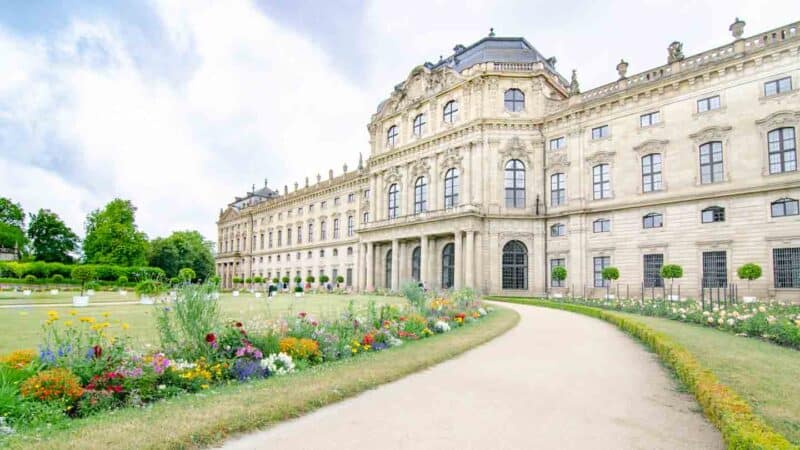
Wurzburg
Wurzburg is the perfect place to begin your Romantic Road adventure, in large part because of its historical architecture and of this Wurzburg Residence is what stands out. Construction of the Wurzburg Residence began in 1720 and was completed 24 years later.
Not necessarily built out of necessity or defense. The palace was constructed under the order of then monarch Johann Philipp Franz von Schonborn who wanted his palace to resemble the Palace of Versailles. His successor halted construction after only the north section has been completed, and his successor saw the construction of the palace completed.
A mix of French and Baroque style architecture the Wurzburg Residence is unique. Inside the palace contains a chapel, gardens, apartments, large halls, and more. The beauty of Wurzburg Palace interior is hard to put to paper, but perhaps the most famous is the staircase.
What’s so special about a staircase? It’s not just any old staircase, it is a masterfully crafted work of art, flanked by more masterful art on all sides, even above you is a beautiful fresco. Wurzburg Palace, with its storied history and beautiful craftsmanship, is perfect for getting in the mindset to take in all the Romantic Road has to offer.
For more info on the residence and tourist information head to their website, you can even take a virtual tour!
- Stay or Visit: Visit
- Importance: “Should See”
- Next Stop – Tauberbischofsheim – Distance: 38 km/24 miles
Tauberbischofsheim
Shortly after Wurzburg along the Romantic Road, you’ll come across the village of Tauberbischofsheim, which is the kind of place you envision this part of Germany. Picture perfect timber-framed houses line the streets painted in a pastel rainbow of colors; the marketplace is well known for this style of architecture.
Aside from the charming streets, Tauberbischofsheim also gives a look more in-depth into the past with a few remnants of the old city wall, most notably the round tower still keep watch over the city. Here you’ll also find a castle bearing the same name as the city, dating back to the 13th century.
If you have more time to linger in Tauberbischofsheim you’ll also find a beautiful church built in the 12th century (rebuilt after a fire in 1914). Lastly, Tauberbischofsheim’s other claim to fame is the sport of fencing, and here you’ll find the Olympic training center. Overall, Tauberbischofsheim is an attractive little village, but if you are tight on time, we would put this stop as optional.
- Stay or Visit: Visit
- Importance: “Optional”
- Next Stop: Lauda-Königshofen – Distance: 11 km 7 miles
Lauda-Königshofen
Located on the banks of the Tauber River, the town of Lauda-Königshofen is another charming stop along the Romantic Road. A highlight of this Bavarian town is the stone bridges crossing the river adorned with sculptures of saints.
If you look further, you’ll find plenty of old-world gems dating back to the medieval times. Dating back many centuries Lauda-Ko was an important trending port for wine, and even today, you can still find grapevines covering the hills outside of town.
- Stay or Visit: Visit
- Importance: “Optional”
- Next Stop: Bad Mergentheim – Distance: 12 km/8 miles
Bad Mergentheim
This city is a cool stop along the Romantic Road. As its name would suggest (bad is German for bath or spa), this town is known for its many spas. If you’re not rushing through your Romantic Road trip, Bad Mergentheim is a great place to stop and relax.
Bad Mergentheim features more than just its spas, there is a popular zoo, and perhaps one of the best-known sights in Bad Mergentheim is the Deutschordensschloss. The Deutschordensschloss is a medieval castle that once was the home of the Teutonic Knights.
You can get a good look inside the castle today because the castle now houses a museum of the Teutonic Order. For more old architecture, there is a monastery that features some frescos dating back to 1468. Stop in Bad Mergentheim for a beautiful spa day, accompanied by a historical tour of the city and museum.
Not sure which spa you want to visit?
- Stay or Visit: Visit or Stay if you have 3 days or more on the Romantic Road
- Importance: “Should See”
- Next Stop: Creglingen – Distance: 25 km/16 miles
- Recommended Bad Mergentheim Hotel: Flair Hotel Weinstube Lochner
Creglingen
If you make it to every stop on the list, you will start to see a trend of picturesque little German villages, one after another, and Creglingen is just that. The must-sees of this village are the Lord’s Church and its famous altar of the Virgin Mary by Tilman Riemenschneider, a very well-known German Sculptor.
If you break for quirkiness while on a road trip, you may want to pull over in Creglingen for their Thimble Museum with all things thimble that draws collectors in from all over the world. Don’t miss the Jewish Museum that documents Jewish history in the Tauber Valley.
- Stay or Visit: Visit
- Importance: “Optional”
- Next Stop: Rothenburg ob der Tauber – Distance: 18km/11 miles
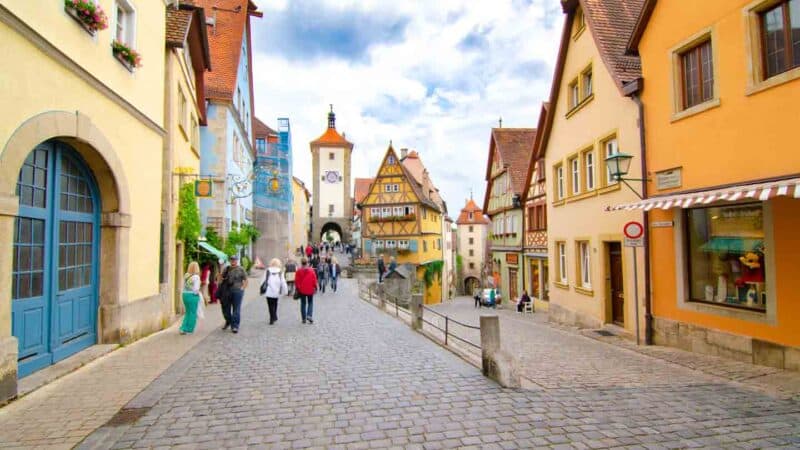
Rothenburg ob der Tauber
Perhaps one of the most popular stops Rothenburg ob der Tauber is known for its historic architecture and its well-preserved architecture. One of the last walled towns in Germany and arguably the most well preserved. Rothenburg is a throwback to a time long ago when nobles ruled the town from their castle, and walls were needed to protect the town. Today you can tour those old walls and much more throughout the city.
There is a “Criminal Museum” which includes exhibits on medieval torture devices. Other places to check out if you’re into the historical architecture is St. James’ Church and the town hall. During World War II, the city suffered damage from air raids. American leaders, recognizing the city’s historical significance, ordered the generals not to use artillery during the assault on the city.
It’s worth noting that Rothenburg ob der Tauber is considered the cultural capital of Bavaria. If you’re looking to experience Bavarian culture (which is one of the attractions of the Romantic Road), then Rothenburg is a must-stop. Spend a few hours walking around the city, taking in the sights and culture, Or stay the night and enjoy a few drinks at one of the local pubs.
Be sure to check out the available Rothenburg tours online here.
- Stay or Visit: Stay – You’ll want lots of time here – See Hotels
- Importance: “Must Visit”
- Next Stop: Dinkelsbühl – Distance: 49km/31 miles
- Recommended Hotel: Glocke Weingut und Hotel
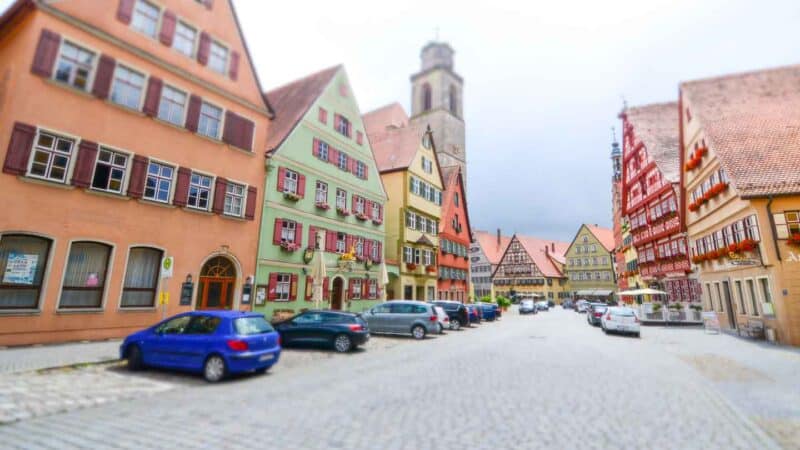
Dinkelsbühl
Dinkelsbühl, like its neighbor to the north (Rothenburg ob der Tauber), is a walled town. Dinkelsbühl is another historical town along the Romantic Road with cobblestone streets, old-style, and closely situated buildings. However, Dinkelsbühl contains many sights that are quite unique to Dinkelsbühl.
St. George’s Minister is a stunning chapel built in the Gothic style. The chapel features a large bell tower attached, and inside the hall is a beautiful display of craftsmanship. The Deutsches Haus in Dinkelsbühl is an excellent place to check out. It’s a fine example of German renaissance carpentry and wooden architecture.
Its location makes it a popular attraction, as it is located in the city’s historical trade center the Weinmarket. The Weinmarket, situated in the center of the city, was once the place where merchants were able to sell their goods in the open. Another historically significant structure in the Weinmarkt is the Rathsernstube. The Rathsernstube is another example of historic architecture, and it used to house the market on official scales and provide lodging for rich customers.
There are several gates throughout the city with guard towers. A unique one is Segringer Tor. Which was damaged once and rebuilt in a Baroque style, providing a different look than the other gates. Dinkelsbühl, offering the familiar Bavarian feel, has many sights that make it worth a visit!
For tour times and prices, feel free to check out the city’s tourist services website!
- Stay or Visit: Visit
- Importance: “Should-See”
- Next Stop: Nördlingen – Distance: 37 km/23 miles
Nördlingen
Just a little further down the Romantic Road, you’ll come across the third of the major medieval walled cities in the town of Nördlingen. The other interesting fact about this town is that it’s built in the crater of a meteorite.
The old tower of the walled city uses the rock formed from that impact. Even though the meteorite landed more than 15 million years ago, you can still clearly see the ring from high above the city from the top of the church spire. To add to the appeal of Nördlingen, besides the walled city and a 15 million-year-old meteorite strike, this town sees much fewer visitors than Dikelsbugh and Rothenburg.
- Stay or Visit: Visit
- Importance: “Should-See”
- Next Stop: Harburg – Distance: 21 km/13 miles
Related Article: How To Spend 3 Days in Berlin
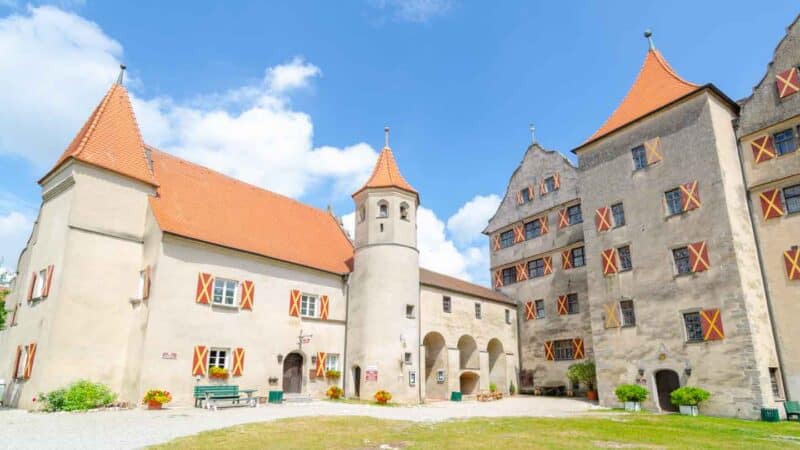
Harburg
If you don’t catch the signs pointing out the exit of the Romantic Road to Harburg, you’ll surely see the large castle perched on a rocky hill overlooking the road and valley below. The main draw here is the large and mostly in good condition castle that has stood here since the 11th century.
As far as castles in Germany go, the is a rather large complex. The walls and courtyard close in a large area on top of the hill with the modern-day Harburg below. In the town, you’ll find more timber-framed homes and nice views of the castle in the background.
If you plan to visit Tuesday-Sunday, you can pay a visit during the Summer months. If you have the time, you can stay in the castle, which has a small hotel and restaurant inside.
- Stay or Visit: Visit
- Importance: “Should-See” almost a “Must Visit”
- Next Stop: Donauwörth – Distance: 12 km/7.5 miles
Donauwörth
Where the Wörnitz and the Danube collide, you’ll find the charming village of Donauwörth. Along with the beautiful buildings and churches, what sets this village apart is the island formed where the rivers meet. Founded in the 12 century, Donauwörth is full of history and worth a visit if you are taking a leisurely tour of Germany’s Romantic Road.
- Stay or Visit: Visit
- Importance: “Optional”
- Next Stop: Augsburg – Distance: 47 km/30 miles
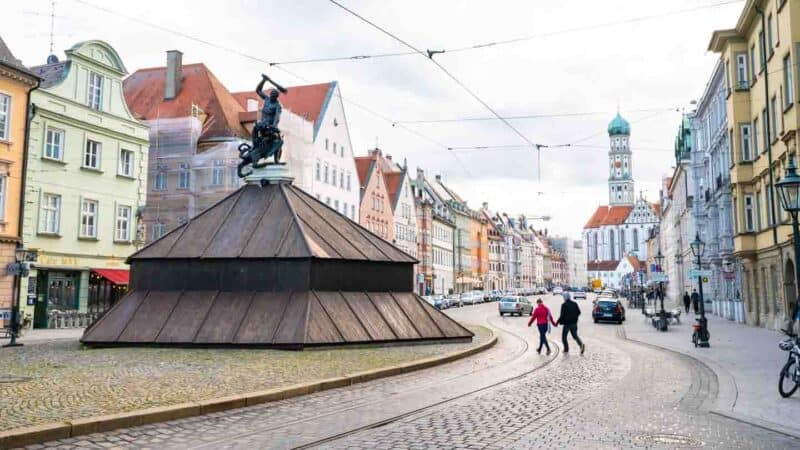
Augsburg
Perhaps one of the oldest cities in the area, Augsburg was founded before the Roman conquering of German tribes. Officially founded in 15 BC, which makes it over 2000 years old! During Roman rule, the city was recognized as a free imperial city and, due to its location along trade routes, saw lots of traffic from travelers and merchants. Today Augsburg is known as a college town and is a fairly popular tourist stop along the Romantic Road.
Given its long history, Augsburg has plenty of sights to offer. The most prominent is arguably the Town Hall. Constructed in 1615-1624 the “Rathaus” still serves as the administrative center of the city. At the time, the building was a feat itself. For example, it was the first in the world to be over six stories tall.
Nearby the town hall, you can check out an ancient tower built over 1000 years ago to serve as a watchtower. It is called the “Perlachturm.” A unique attraction is the Augsburg synagogue. One of the few surviving German synagogues after WWII, there is now a Jewish museum there for you can check out.
Other attractions include Mozart Haus Augsburg (Mozart’s father’s home), St. Anne’s Church, Schaezlerpalais (A rococo-style mansion that hosts an art museum), the Botanical Gardens, A Roman Museum. It’s important to note Augsburg’s significance during the religious reformation of Europe. Because of this, there is a mix of Catholic and Lutheran churches in Augsburg. Even one conjoined Abbey, St. Ulrich, and St. Afra, which is somewhere to visit while you’re in Augsburg.
- Stay or Visit: Visit
- Importance: “Should See”
- Next Stop: Landsberg – Distance: 42 km/26 miles
Landsberg
The closest city to Munich along the Romantic Road, today and always. Landsberg has been at an important intersection at the border of Bavaria and Swabia. Landsberg boasts more stunning architecture dating back to the 13th century. During those times, Landsberg was on a major historic Salt Road, which leads to the fortifications to help protect the salt trade and of course, to collect a toll to cross its bridges. Again you’ll find many beautiful buildings here and several historic and ornate churches.
- Stay or Visit: Visit
- Importance: “Optional”
- Next Stop: Schongau – Distance: 28 km/17 miles
Related Article: 20 Things To Do In Cologne
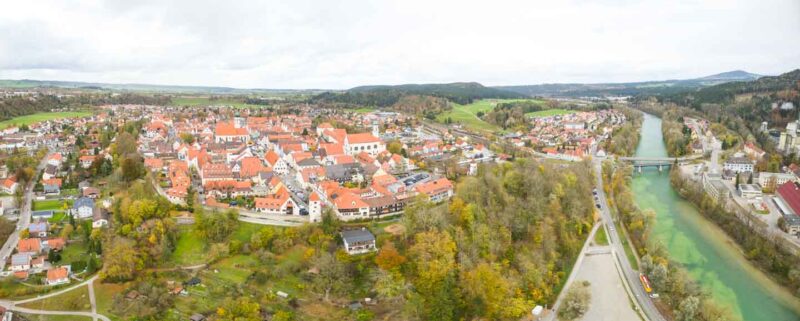
Schongau
Just before the Alps start to come into view when heading south down the Romantic Road, you’ll find the town of Schongau. High on a flat, wide hilltop surrounded by a short wall ringing the city. This strategic position on the hill has supported life and settlement here for centuries, with Roman remains and brazen age items being unearthed here in Schongau.
In modern times, you’ll find a very charming old town city full of Timber-framed buildings topped with red roofs. However, what you may not find is parking up here in the old part of town. If that’s the case on your visit, there are lots below and paths to walk up and explore this cute little town.
- Stay or Visit: Visit
- Importance: “Optional”
- Next Stop: Steingaden – Distance: 20 km/13 miles
- Recommended Schongau Vrbo
Pfaffenwinkel & Steingaden: The Wieskirche
Wies Church, or in the native tongue Wieskirche, is purportedly the most important place of pilgrimage in Bavaria. Created during the Rococo era for architecture, it is quite different than the medieval churches and monasteries around Germany. Rococo architecture is generally associated with elaborate ornaments, and the Wies Church is certainly not lacking in that category.
From the outside, the building appears rather ordinary for a church, a large hall with a bell tower painted white. But once you enter, you are confronted with an immense amount of gold ornaments on a white background. Every column, wall, and window sill has some sort of aesthetic design.
The most awe-inspiring, however, is probably the rotunda with incredibly intricate decoration adorning a beautiful fresco. The church’s location adds to its spiritual aura, often called the “Flower in the Meadow” Wies Church is located between Seingaden and Wildsteig off the beaten path in a peaceful meadow.
Why this church became such an important pilgrimage location is quite an interesting story. In 1738 it was said that tears were seen in the statue of the “Scourged Savior.” This sparked a pilgrimage of Christians from across the land to see the sculpture and pray. The Wieskirche is a UNESCO World Heritage site, so it isn’t going anywhere. If you’re on the Romantic Road, don’t miss your chance to make a pilgrimage of your own.
The Wies Church is still a functioning place of worship, so if you’re going to visit, be sure not to interrupt any religious festivity or ceremony. You can find good visiting times here on their website.
- Stay or Visit: Visit
- Importance: “Optional”
- Next Stop: Schwngau – Distance: 18 km/11 miles
Schwangau
The seconded to last main stop on the traditional Romantic Road. From the outskirts of town, you’ll surely see the mighty Alps coming into view as you approach Schwangau. Between here and Füssen, you’ll be driving through picturesque pastures and rural villages.
Schwangau is another alternative to staying in the very popular Füssen while visiting the stunning castles between the two cities. Also, there are some great hiking opportunities just outside the village and nice mountain views.
- Stay or Visit: Visit or stay as an alternative to Füssen – See Hotels here
- Importance: “Optional”
- Next Stop: Füssen – Distance: 3.5 km/2 miles
- Recommended Schwangau Hotel: Landhotel Guglhupf
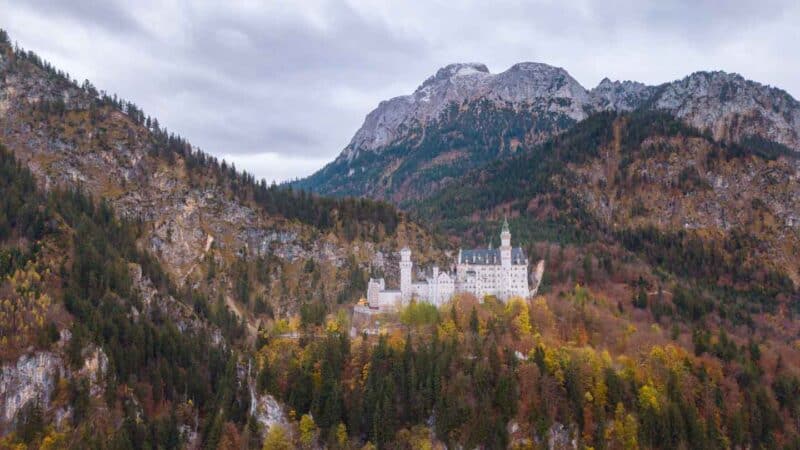
Füssen
Located near Germany’s southern border with Austria, Füssen is the end (or beginning) of your Romantic Road adventure. Fussen is situated at the foot of the Alps, with the Lech River running through it. Historically Füssen dates back to the Roman era, which used it as a station for defending and shipping trade. Today Fussen is known for its castles, or at least its proximity to them.
Two of the most popular castles in Germany are nearby, the Neuschwanstein and Hohenschwangau. For a brief look at them, be sure to check out our 10 Amazing Fairytale Castles In Germany You Cannot Miss. Füssen has other attractions, of course. St. Mang’s Abbey is an ancient monastery that dates back to the 9th century and still hosts mass to this day.
Alongside the Abbey, you can check out the local city center High Castle which was built around the 14th century. Altstadt von Fuessen is another popular attraction, a well-preserved old town you can get a real sense of what the city may have been like. There is a museum that is near the St. Mang’s Basilica. The museum focuses on art and violins (a popular export of the city) and is housed in a Baroque style abbey.
What makes Füssen unique compared to the rest of the Romantic Road is the setting. Being at the foot of the Alps, the town is built in a valley with beautiful wooded hills in the distance and a lake to the north. The surrounding hills provide countless nature trails and parks that are perfect for hikes or bike rides.
We stayed in one of the cutest Vrbosin Füssen, and it was only $141 a night minutes away from Neuschwanstein Castle. You can read our review in October 2017.
The Romantic Road contains many more stops than just those listed here. If you intend to take the road yourself, tourist signs are designating where to go to follow the Romantic Road route.
- Stay or Visit: Stay
- Importance: “Must Visit”
- Next Stop – End of Romantic Road
- Recommended Füssen Hotel: Hotel Hirsch
If you have time after time Fussen, consider taking a road trip to the country Liechtenstein, which is only 2 hours away from Fussen. Liechtenstein is one of the smallest & wealthiest countries in the world and worth the trip. Here are some of the best Liechstein attractions to visit.
Romantic Road FAQ
Q: Why is it called the Romantic Road?
A: The Romantic Road was created after the second world war in 1950 as a means of bringing tourists to the region. It is based around an old Roman route, hence the “Romantic.” While the route has its roots deep into history, exploring it in this way is a more modern but brilliant invention.
Q: Can you visit the Romantic Road in the winter?
A: Yes, you can visit the Romantic Road during winter, you will find most visiting hours greatly reduced, and some sights completely closed during this season. However, on the plus side, you’ll see very few other tourists. Even more pros to a winter visit to the Romantic Road is that some of the sights like Neuschwanstein Castle are stunning with a little bit of fresh snow on them.
Q: Can you self-drive the Romantic Road in Germany?
A: Yes, one of the best ways to see all of the Romantic Road is to self-drive. Tours of the Romantic road are available, but those who like to travel independently will enjoy the scenic drive. Renting a car in Germany is really easy, and we have always gone this route ourselves.
Romantic Road Tips
Book your hotels early if you are traveling in the summer. This route is among the most popular in all of Germany, and accommodation can get scarce during peak seasons.
Other German Castles Worth Visiting Not On The Romantic Road
- Burg Eltz | Address: 56294 Wierschem
- Cochem Castle | Address: Schlossstraße 36, 56812 Cochem
- Mespelbrunn Castle | Address: Schloßallee, 63875 Mespelbrunn
- Liechtenstein Castle| Address: Schloß Lichtenstein 1, 72805 Lichtenstein
More On Germany
We narrow down 20,000 castles in Germany to a list of the 10 best to help you plan your next German Castle Road Trip! Germany’s Romantic Road takes you on a historical path through Southern Germany. The Romantic Road, or Romantische Straße as the Germans call it, is a journey from Wurzburg to Füssen…. Hip and trendy, Berlin has it all! If you’re looking for a fun city full of history and culture; this is the perfect place for you! Formerly divided into East…10 Best Castles In Germany You Need to Visit – 2024 Guide
Everything You Need to Know About Germany’s Romantic Road
3 Days in Berlin: From Berghain to the Brandenburg Gate
Don’t Forget to pin me for later!
